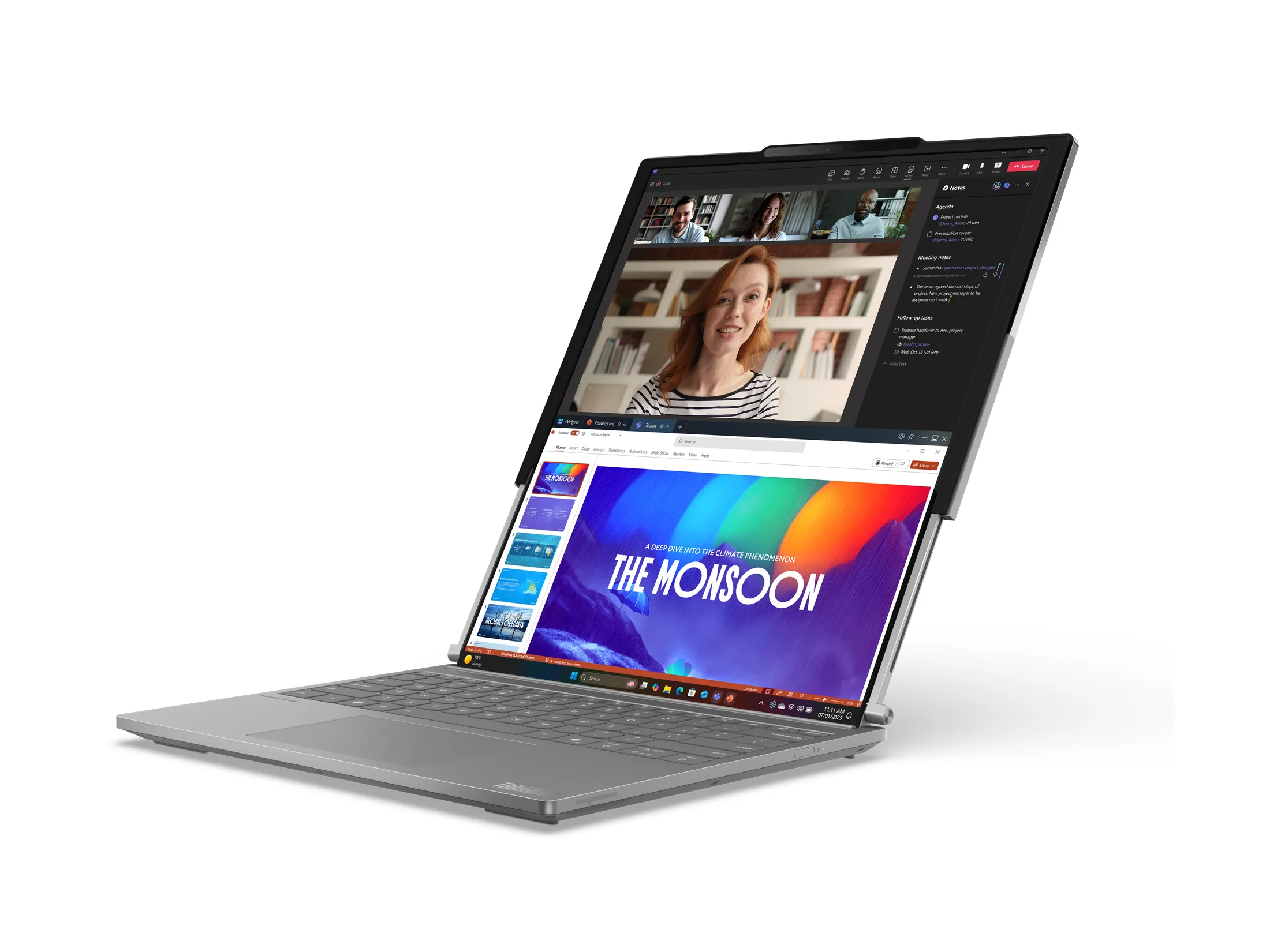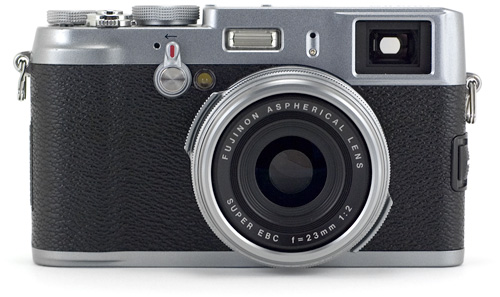
By Andrew Liszewski
Back in March we had our first opportunity to play with Fujifilm’s new FinePix X100, and more recently we were able to take it for a longer test drive outside of a press event setting. Unfortunately, because of the limited availability of the camera due to recent events in Japan, and the high demand, we were only able to spend a long weekend with it. And while we were able to glean some more in-depth impressions of Fujifilm’s homage to the classic rangefinder, we don’t feel we’ve had enough time with it to put together a proper review. So consider this a more elaborate ‘hands-on’ look at the camera. (If you are looking for an exhaustive and thorough review of the X100 we encourage you to check out DPReview’s in-depth look at the camera. As usual they go above and beyond the call of duty.)
But that doesn’t mean we haven’t come to any of our own conclusions about the FinePix X100. If you like the idea of carrying a camera with a DSLR sized APS-C sensor, minus the weight and bulk of an actual DSLR, the X100 is a strong contender. Particularly if you’ve got a soft spot for the charm and analogue controls of an old-school rangefinder, but prefer the convenience of digital over film. More after the jump.
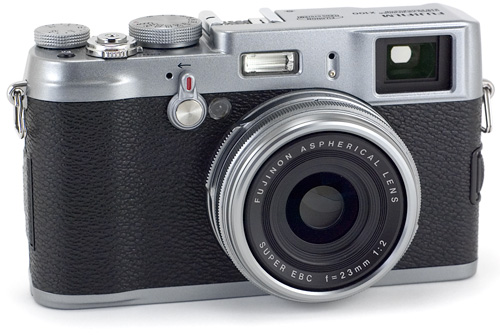
It’s definitely up for debate, but if you ask me, the FinePix X100’s raison d’être is first and foremost its looks. It’s certainly an incredibly capable camera, with the aforementioned 12MP APS-C sized sensor and enough features to put it in competition with even a mid-range DSLR. And while many buyers will be seriously considering it as a lighter alternative to a DSLR without sacrificing image quality or functionality, it’s the old-school body and stylings that I’m sure will be the first thing to catch a photography enthusiast’s eye.
Fujifilm has done a great job at making the X100 look like an old school rangefinder film camera. And from the front it can easily be mistaken for one. In fact I think it has more retro charm than even something like the Leica M8, which is particularly nice because at $1199.95 it’s also considerably cheaper. So it’s no surprise that demand for the X100 has been high since it was originally revealed at Photokina last year.
The camera’s magnesium alloy body makes it feel incredibly solid in hand, and it has the perfect amount of heft to make the price tag, which is admittedly even more expensive than a comparably equipped DSLR, feel worth it. And the faux leather plastic finish that wraps around the housing feels perfectly suited to the X100’s almost post-modern design, instead of just feeling cheap. The various dials and levers also add to its retro appeal. And while you don’t get a good sense of its size or scale with it sitting by itself, in hand the X100 feels relatively small. It’s obviously a bit larger than a compact P&S, but if you’re used to hauling around a large DSLR all day, it’s going to feel downright tiny.
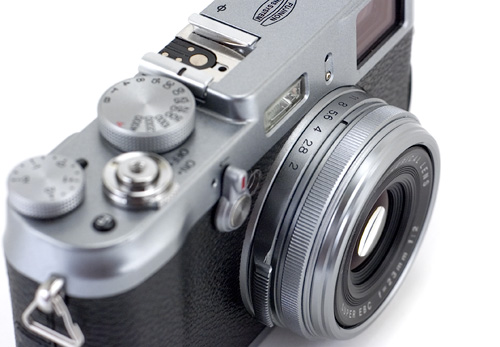
Now one of the things that will prevent many loyal DSLR users from switching to the X100 is its 23mm (35mm equivalent field of view) prime lens that isn’t swappable. I know a lot of photographers like to spend their time with a nifty fifty prime, but most of my camera work away from my lightbox is done at tradeshows and press events. So being able to zoom past crowds and annoying idiots snapping camera phone pics is a must. But for more creative ventures the X100’s lens is certainly a nice option. It has a maximum aperture of f/2 making it great for low-light situations, or those who like the occasional shot with a really shallow depth-of-field.
Adjusting the f-stop is done semi-exclusively via a ring on the lens, and by default it does that in one-stop increments from f/2 up to f/16. (There’s also a red ‘A’ for an ‘auto’ mode.) However, the f-stop can further be adjusted using a small black lever on the back of the X100 in one-third-stop increments if you need to fine tune your settings. You can’t cycle through the entire f-stop range using the lever, only above and below the f-stop number selected on the dial, but I think the system works well enough. It took a little getting used to having to switch the f-stop using the lens ring, instead of just a dial on the back of the camera, but I’ll admit there’s a certain appeal to it.
You’ll also notice the FinePix X100’s focus ring sitting in front of the aperture ring. While technically it lets you ‘manually’ focus, it’s actually just controlling an electronic focusing mechanism. It allows you to make very fine adjustments to your focus when slowly turning the ring, but for grossly changing the focus you’ll have to make a few full rotations. In other words I prefer how it works on my DSLR, but it’s certainly very functional on the X100. And the fly-by-wire focus system it uses is smooth and continuous, where in some cameras it’s handled in stuttered increments which makes fine adjustments very difficult.
Finally, out of the box the X100’s lens can’t accept filters or accessories. It does include a solid feeling metal lens cap (which unfortunately isn’t tethered to anything) but if you want to use a filter or even a lens hood you’ll need to unscrew a metal ring at the front of the lens and switch it with one that’s threaded for filters. Which is unfortuantely an optional accessory, and not included in the box.
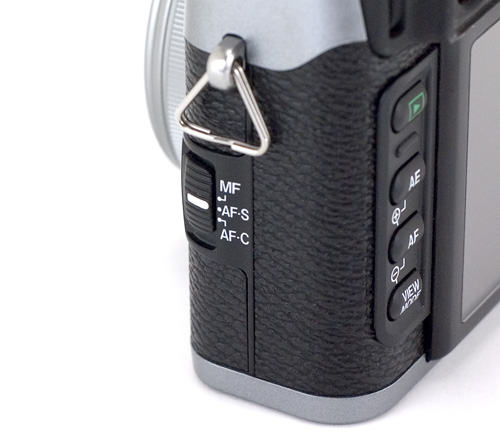
Of course the majority of my time with the camera was spent with the focus running in automatic mode, which can be set via a three-way switch on the side of the camera. Your standard manual, autofocus-single and autofocus-continuous options are there, though the loose nature of the sliding switch can make it easy to overshoot when switching from manual to the more frequently used AS-S. And while there’s nothing wrong with the continuous mode, it does tend to wear down the battery quicker.
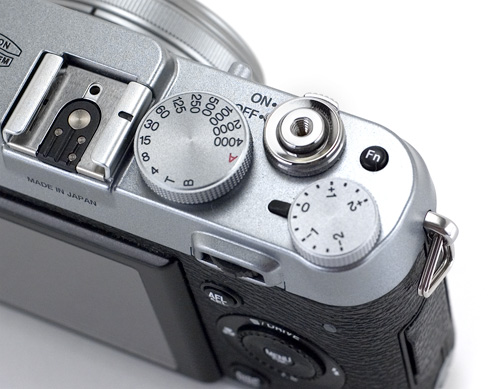
While the aperture settings are controlled primarily via the ring on the lens, the X100’s shutter speed is controlled by a dedicated hardware dial on the top of the camera. It’s also adjustable in whole-stop increments from 1/4 second to 1/4000 second, and like with the aperture ring you can make finer adjustments above and below the selected shutter speed using the navigation dial on the back of the camera. I have to say I really like being able to almost instantly switch to a faster or slower shutter speed as needed, compared to having to roll a thumbwheel on my Nikon DSLR.
The dial also has an ‘A’ setting for automatic, a ‘T’ setting allowing for longer exposures up to 30 seconds and a ‘B’ or bulb setting for manually opening and closing the shutter at your discretion. In fact, you’ll notice the shutter/autofocus button even has a threaded hole on top allowing you to connect a mechanical cable release. On top of the camera you’ll also find the power switch which is integrated into the shutter button. A small black button labeled ‘FN’ which when pressed can be used to change customizable settings, though by default it lets you easily change the ISO which is by far its most useful function. And an exposure compensation dial which ranges from +/-2 EV.
At first the top of the X100 might look a little cluttered an intimidating to compact P&S camera users, but it’s actually fairly clean and straightforward, and I found the dials to be intuitively placed so that in no time I was able to tweak settings without having to remove my eye from the viewfinder.
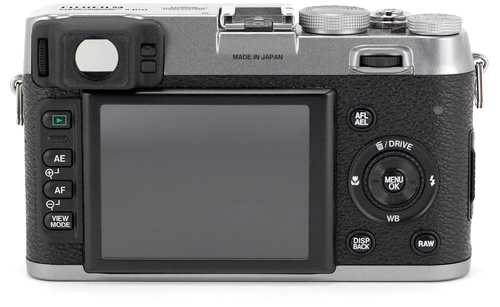
As I’ve already pointed out, when looking at the X100 from the front you could easily mistake for an old-school film camera. But from the back, its 2.8-inch LCD display and moderate array of buttons makes it immediately obvious it’s a modern digital alternative. Oddly enough the way the screen is mounted with its rounded plastic border makes it look like it’s able to pop-out or be pivoted, but it can’t. And while the 460,000 pixel resolution provided more than enough detail, it did have the tendency to get fairly washed out in direct sunlight. Thankfully in those situations the X100 has an incredibly useful and innovative viewfinder I’ll talk about later.
To the left of the LCD are a series of 4 buttons which let you switch to playback mode and zoom in and out of an image while scrolling through photos. Adjust the AE mode between spot, center weighted and pattern. Adjust where and how the Auto Focus evaluates a scene, or magnify part of an image to assist with manual focusing. And with the ‘VIEW MODE’ button you can change what information is displayed on the LCD. It toggles through various modes including a clean live preview with minimal information overlaid on the display, and a considerably more robust OSD that can be customized six ways from Sunday in the menus including grid overlays, live histograms and even an active horizontal level. Which, I must say, is a far easier way to keep a photo level than relying on just a static grid.
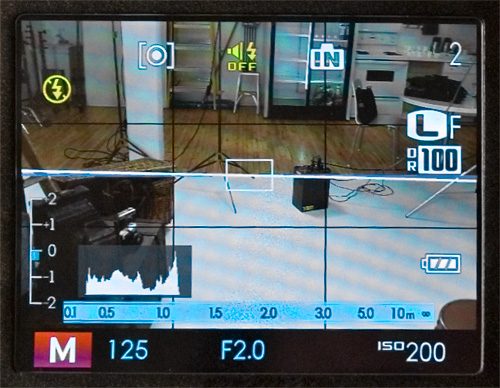
Admittedly I did find the lack of a consistent graphical treatment for icons, fonts and the on-screen displays made the X100’s live preview seem a little on the busy side when fully tricked out. So I think if Fujifilm went back and added just a touch more polish and consistency it would make the overload of displayable information available far more manageable at a quick glance.
Finally, to the right of the LCD you’ll find another array of buttons including the ‘AFL/AEL’ which lets you lock exposure and focus, or still trigger autofocus even when you’ve set the focus to manual. A ‘DISP/BACK’ button which is primarily used when navigating the on-screen menus and for toggling through how much information is presented on the LCD’s live display. A jog lever which is primarily used for tweaking the aperture setting between the full-stop values available on the aperture lens ring. A dedicated ‘RAW’ button which lets you turn RAW capture on and off on a shot-by-shot basis, or play with the camera’s RAW conversion settings while browsing photos. And finally, a 4-way controller which also doubles as a scrollable wheel. It provides quick access to flash, macro, white balance and delete options, as well as ‘DRIVE’ which is basically how many photos the camera takes every time you press the shutter button. It of course also allows you to bring up and navigate the X100’s menu system, which is one of my few gripes about the camera.
Scrolling a wheel is certainly one of the quicker and more efficient ways to navigate a long list of menu options, but the scroll wheel on the back of the X100 is pretty finicky. Since it doubles as a 4-way controller also allowing you to make selections, it’s pretty easy to accidentally pop into a sub-menu you didn’t mean to. And the ‘OK’ button in the middle I found was far too small to quickly and easily mash with my thumb when I wanted to make a selection. I realize there’s not a lot of room on the back of the X100 to work with when it comes to improving the scroll wheel’s design, but I definitely think this should be high on Fujifilm’s list for future versions of the camera.
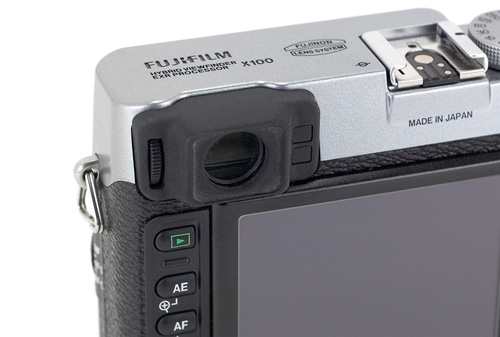
One of the most lauded features of the FinePix X100, is its hybrid viewfinder. And it certainly deserves all the praise that’s been heaped upon it. The LCD technology included on digital cameras is rarely usable in situations with bright sunlight, but switching to the viewfinder usually means you have to sacrifice seeing all of that useful onscreen information you get on the larger LCD display. That’s not the case with the X100 though.
Fujifilm has developed a unique system whereby you can still see all of that information displayed over your scene when peering through the viewfinder. In fact, you can even switch the viewfinder to serve as a completely electronic viewfinder at the flick of a lever on the front of the camera, which is handy if you’d like to see a more closer representation of what the camera’s sensor will capture in terms of framing. When looking at the image through the viewfinder optically you actually see a lot of more than what will be captured by the camera, including the lens which sticks into the lower right corner of your image.
I particularly like that the X100 has sensors located next to the viewfinder so that when you hold it up to your face it automatically turns off the larger LCD display on the back of the camera to conserve battery life. It does make it more difficult to chimp and see a larger version of the photo you just took while looking through the viewfinder though, which at times got a little frustrating. But the hybrid viewfinder system definitely works very well, and I’ve no doubts you’ll see similar features appearing on cameras from other manufacturers down the line.
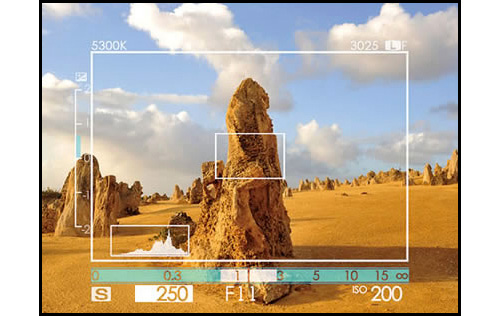
The information it provides via its own onscreen display is very much similar to what you see on the camera’s large LCD display, including real time histograms, exposure charts and even the virtual horizon line. And like the larger display this can be fully customized in the camera’s menu system. I also noticed that the overlay in the viewfinder was able to intelligently lighten or darken itself depending on the scene you were looking at so that it was always visible with the optimal level of contrast. Unfortunately when switching to the fully electronic display in the viewfinder things tended to look a little washed out and dim, but I’m sure this is something the company will improve as they develop and refine their hybrid viewfinder technology.
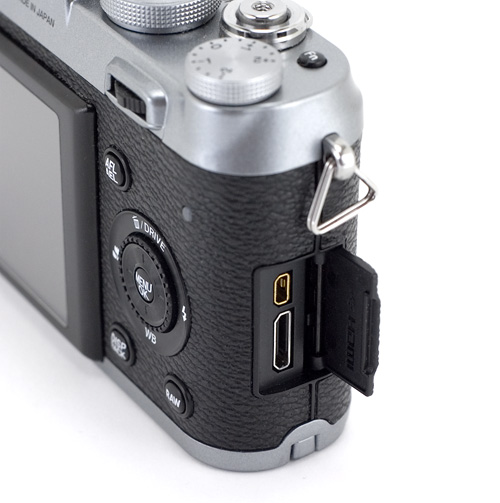
On the side of the camera opposite the auto/manual focus lever you’ll find a small door hiding a micro USB and mini HDMI connection. I understand why companies put these smaller versions of popular ports on their devices to keep the size down, but I actually hate having to keep a mini HDMI cable on hand in addition to the standard sized ones. And even though I didn’t test it over the weekend I spent with the X100, the camera is also video capable. Though it can only capture 720P @ 24fps in 10 minute clips. So needless to say no one will be picking up the X100 solely for shooting video. But it’s always nice to have.
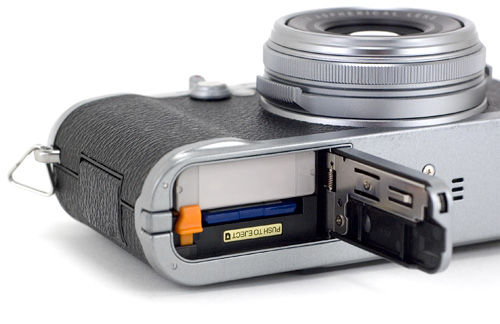
On the underside of the X100 you’ll find a standard tripod mount (not pictured) as well as a door where the battery and SD card are stored. Personally I prefer the SD card on a digital camera to be accessible via a slot on the side of the body since it means it can be easily removed and swapped while the camera is attached to a tripod. But again, I understand the reasoning for grouping the battery and memory card together to keep the camera compact.
The X100 includes an NP-95 rechargeable lithium-ion battery which is rated at about 300 photos, assuming you’re stingy with the LCD. And oddly enough, while the battery does have a unique, rounded and contoured shape, it’s actually pretty easy to stick it in the battery compartment upside down. Usually batteries and their slots are designed so they can only be inserted one way, but not on the X100. And the only indication you’ll get that you’ve done it wrong is that the camera won’t turn on. So if you don’t realize you’ve put it in incorrectly, you’re going to get frustrated at troubleshooting really quickly.
Finally, what’s a camera hands-on without a few sample shots? But since I usually find your standard landscape photo pretty pointless when it comes to seeing what a camera is really capable of, I decided to play with the X100’s macro capabilities, which when combined with the f/2 capable lens left me pretty sad to see the camera go.
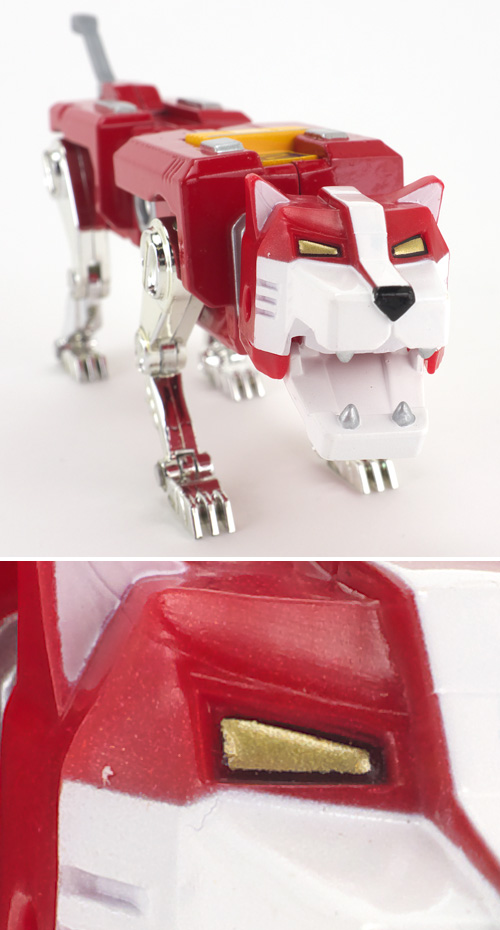
Fujifilm FinePix X100 – f/16 @ 1/30sec (top: resized | bottom: full size crop)
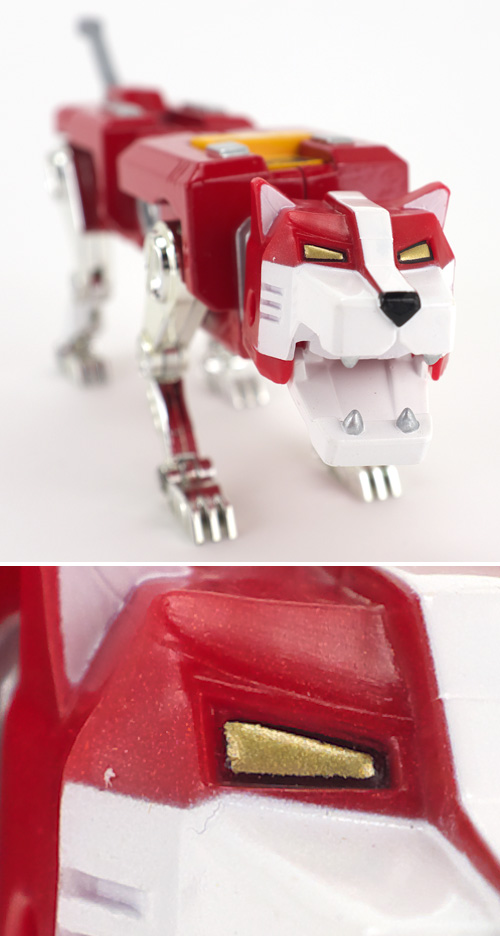
Fujifilm FinePix X100 – f/8 @ 1/125sec (top: resized | bottom: full size crop)
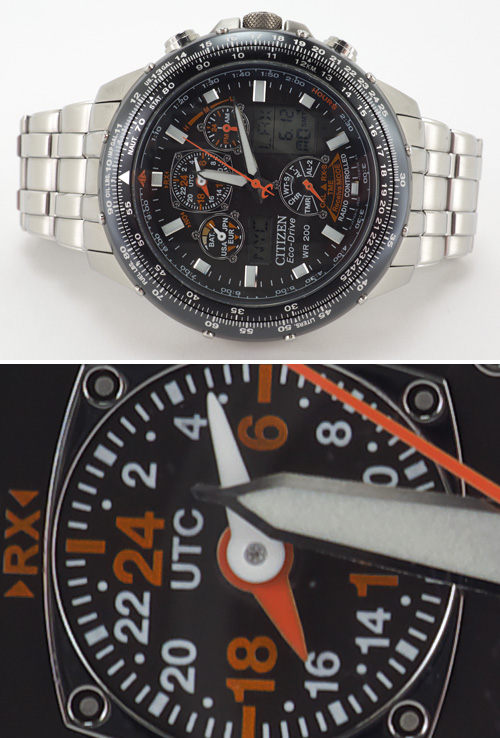
Fujifilm FinePix X100 – f/16 @ 1/15sec (top: resized | bottom: full size crop)
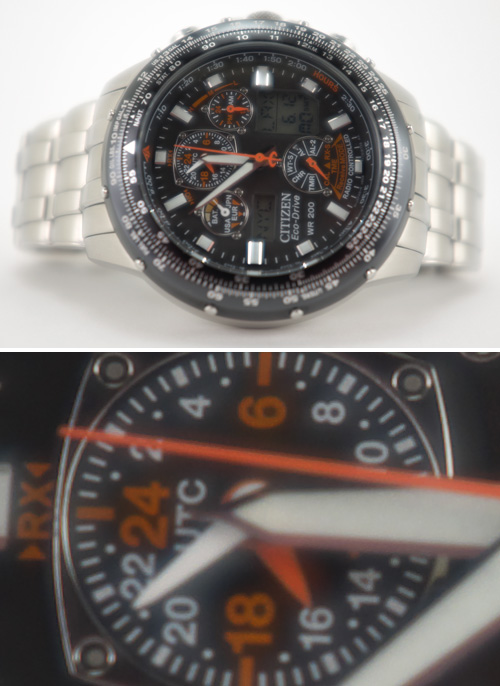
Fujifilm FinePix X100 – f/2 @ 1/500sec (top: resized | bottom: full size crop)
The camera performed as well as I expected it to, though I was a little surprised with all the blooming on the highlights on this particular watch shot with the aperture all the way open to f/2. It wasn’t really as apparent on photos with less shiny objects though, and other macro shots taken of objects outside didn’t exhibit the same results.
But overall the Fujifilm FinePix X100 is a surprisingly capable alternative to a full-sized DSLR. As far as options go it puts even high-end P&S cameras to shame, and even a few budget DSLRs as well. We unfortunately barely had enough time to scratch the surface of what the camera was capable of or how it could be configured for our own shooting preferences. So suffice to say there’s enough customizability to make even professional photographers satisfied to carry this around as their casual shooter.
The lack of a swappable lens does make it a tough sell against Micro Four Thirds cameras from the likes of Panasonic which do provide a small selection of lens alternatives. And particularly when compared to Sony’s NEX cameras which also feature a larger APS-C sensor like the X100, but again with swappable lenses. But if you’ve already got a DSLR and have made a heavy investment in extra glass, I doubt you’ll be looking for a smaller alternative that you can also buy extra lenses for. So as a weekend or evening alternative to a hefty DSLR, I think the X100 will certainly appeal to a large number of photographers.
We did walk away a bit disappointed with how the camera performed in its automatic modes. We know the DSLRs we’ve used for years do a fantastic job at evaluating a scene and producing a well-exposed shot when left to their own automatic devices. But for the most part we found the X100 tended to overexpose things more often than not. Now admittedly we didn’t adjust the camera’s metering mode either, which could have been an instant solution to the problem. So we’re hoping that it was either something peculiar with the firmware on the camera we were loaned, or a setting we missed.
Unfortunately I still feel we were only really able to scratch the surface with the X100 during the weekend we spent with it. But we can say with certainty that there are far worse ways to spend $1,200 on photographic gear. The hybrid viewfinder alone is enough to put a smile on any photographer’s face, but with the X100 you’re definitely getting far more than a one trick pony with a pretty, retro-styled face.
Links:
Fujifilm FinePix X100 – $1,199.95
If you have any questions about the Fujifilm FinePix X100 you’d like answered, please feel free to leave them in the comments, and I’ll try to respond to them as best I can.










